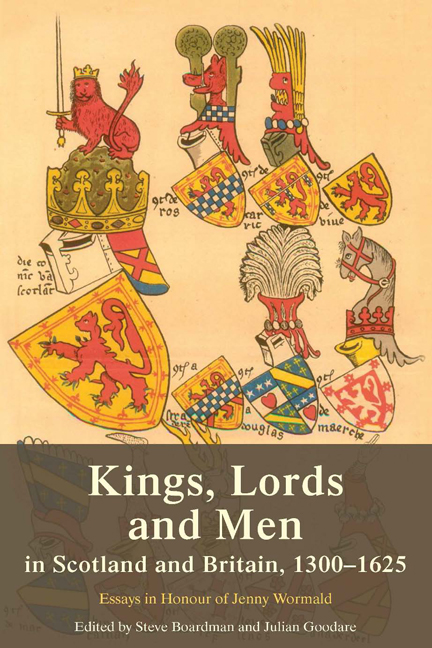Book contents
- Frontmatter
- Contents
- List of Illustrations
- Preface
- List of Abbreviations
- List of Contributors
- Introduction: Kings, Lords and Jenny Wormald
- 1 The Stewart Realm: Changing the Landscape
- Part I Lords and Men
- 2 Lords and Women, Women as Lords: The Career of Margaret Stewart, Countess of Angus and Mar, c.1354–c.1418
- 3 Bastard Feudalism in England in the Fourteenth Century
- 4 Tame Magnates? The Justiciars of Later Medieval Scotland
- 5 King, Lords and Men in Renaissance England: The Poetry of John Skelton
- 6 Rethinking the Justice of the Feud in Sixteenth-Century Scotland
- 7 Bonding, Religious Allegiance and Covenanting
- 8 ‘We Bund and Obleiss Us Never More to Querrell’: Bonds, Private Obligations and Public Justice in the Reign of James VI
- Part II Kings and Lords
- Publications of Jenny Wormald
- Index
4 - Tame Magnates? The Justiciars of Later Medieval Scotland
from Part I - Lords and Men
Published online by Cambridge University Press: 15 December 2017
- Frontmatter
- Contents
- List of Illustrations
- Preface
- List of Abbreviations
- List of Contributors
- Introduction: Kings, Lords and Jenny Wormald
- 1 The Stewart Realm: Changing the Landscape
- Part I Lords and Men
- 2 Lords and Women, Women as Lords: The Career of Margaret Stewart, Countess of Angus and Mar, c.1354–c.1418
- 3 Bastard Feudalism in England in the Fourteenth Century
- 4 Tame Magnates? The Justiciars of Later Medieval Scotland
- 5 King, Lords and Men in Renaissance England: The Poetry of John Skelton
- 6 Rethinking the Justice of the Feud in Sixteenth-Century Scotland
- 7 Bonding, Religious Allegiance and Covenanting
- 8 ‘We Bund and Obleiss Us Never More to Querrell’: Bonds, Private Obligations and Public Justice in the Reign of James VI
- Part II Kings and Lords
- Publications of Jenny Wormald
- Index
Summary
The question mark in the title of one of Jenny Wormald's earliest papers, ‘Taming the magnates?’ was perhaps more provocative when published in 1972 than it might be now. The paper challenged the then established view that later medieval Scotland was characterised above all by conflict, often bloody, between a weak Crown and an over-mighty nobility. The arguments – that actually the Crown–nobility relationship was generally ‘close and cooperative’, that the Crown smashed noble families that became too powerful while building up and rewarding those who served the king, and that in general Crown and nobility were allies with a common agenda – still provoke debate; but there can be no return to the point of departure. This chapter seeks no more than to highlight a particular contribution to medieval royal government by members of the nobility that, while much more than negligible, has not yet received the attention it deserves.
Geoffrey Barrow's seminal study of the Scottish justiciar to c.1306 showed that by the mid-thirteenth century the office was divided regionally, the two most important regions being Lothian and Scotia (the region north of the Forth–Clyde line), and generally held by major figures from the nobility. The justiciar for each region went through it twice annually on circuit, or ayre, holding courts exercising both a criminal and a civil jurisdiction. Although a new structure created in 1305 under Edward I with four justiciary regions (Lothian, Galloway, Forth to Mounth, and north of Mounth) certainly came into operation, the previous system was revived quickly by Robert I and continued until the beginning of the sixteenth century. During this period, the justiciarships were usually said to be either ‘north’ or ‘south of Forth’. The present contribution identifies holders of these offices from the reign of Robert I until the 1513 appointment of Colin Campbell, third earl of Argyll as justiciar general of the whole realm of Scotland north and south of Forth, thereby confirming what had in fact been the position since 1501, when the offices north and south of Forth were combined in the person of Andrew, second lord Gray.
- Type
- Chapter
- Information
- Kings, Lords and Men in Scotland and Britain, 1300-1625Essays in Honour of Jenny Wormald, pp. 93 - 120Publisher: Edinburgh University PressPrint publication year: 2014



